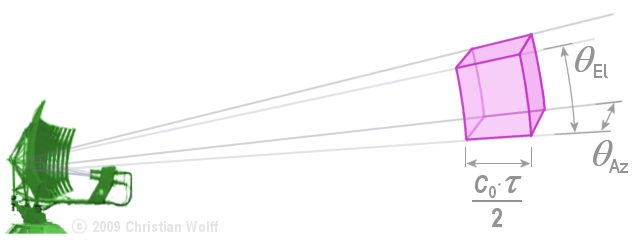The Resolution Cell

Figure 1: The resolution cell
What is the radar resolution?
The Resolution Cell
The range and angular resolutions lead to the resolution cell. The meaning of this cell is very clear: unless one can rely on eventual different Doppler shifts it is impossible to distinguish two targets which are located inside the same resolution cell.

Figure 1: The resolution cell
One usually assumes that the impulse volume is fixed by the aperture angle φ (or
half power (-3 dB) angle)
of the antenna beam and the range resolution ΔR as being the value
ΔR corresponding to Δt = τi.
Hence, ΔR = cτi/2.
(i.e. The duration of a signal at the output of
pulse compression
circuits obtained by internal modulation.)
The broader the spectrum of the transmitted pulse and the narrower the aperture angle is, the smaller the resolution cell is and the higher the interference immunity of the radar station is.
The resolution should not be confused with accuracy. Nevertheless, in most radar projects, a first guess for the accuracy figure (one standard deviation) will be half the value of the corresponding resolution. When the radar is realized, the accuracy is frequently better than the first guess because: e.g., the range accuracy is a characteristic of the measurement of the elapsed time between the departure of the transmitted pulse and the arrival of the echo at the receiver. If the transmitted pulse is a perfect rectangular one, the received pulse will look like a Gaussian curve because the receiver bandwidth is finite; in addition, the noise will disrupt the Gaussian shape of the received pulse. Hence it is obvious that the accuracy of this measurement is not really linked to the pulse width (which defines the range resolution) but rather on the receiver signal strength (which is linked to the range). Hence the range error should increase with the range.
